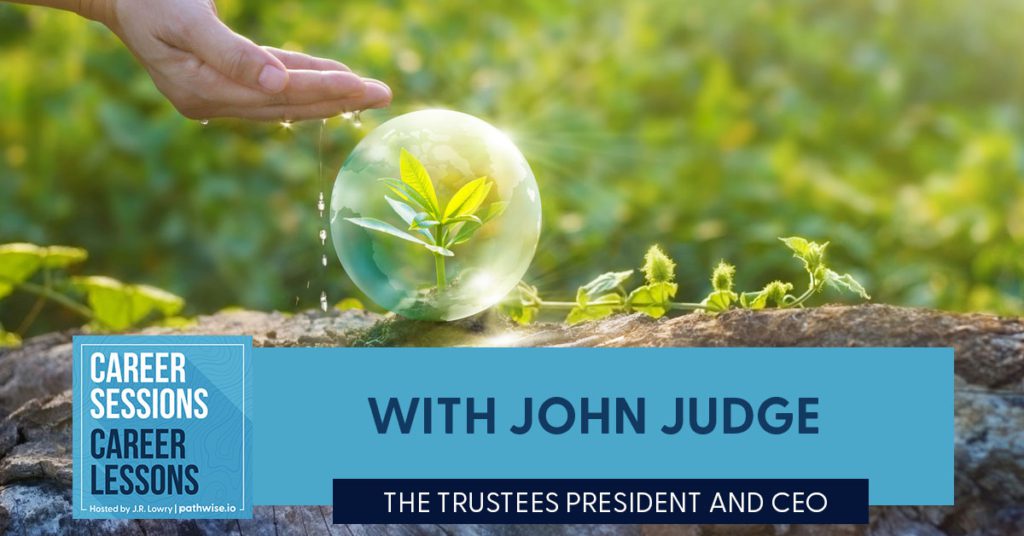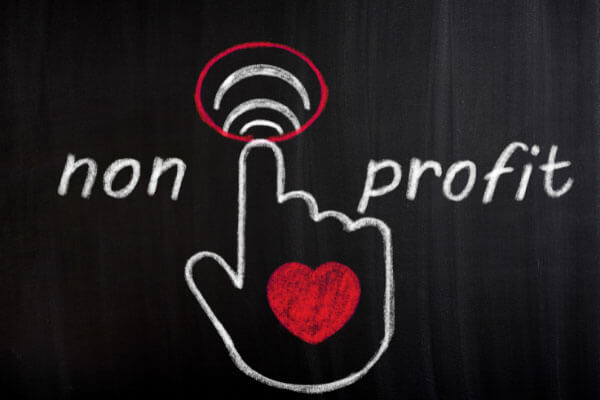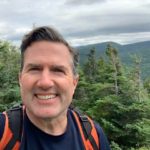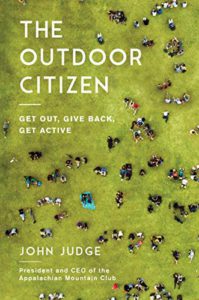
John Judge, The Trustees President And CEO
Now more than ever, protecting the outdoors has become—and should be—the priority. One of the people helping create positive changes and moves for the environment is John Judge. John is the President and CEO of The Trustees, a non-profit land conservation and historic preservation organization dedicated to preserving natural and historical places in the Commonwealth of Massachusetts. He joins J.R. Lowry to share insights on what it’s like to run a non-profit. John also offers valuable advice on leadership and fundraising for leaders in the sector. Listen in on their enlightening conversation for more insights.
—
Listen to the podcast here
John Judge, The Trustees President And CEO
On a Career In The Non-Profit Sector And On The Importance Of Protecting The Outdoors
In this episode, I have the pleasure of welcoming John Judge to the show. John’s career thus far spans the nonprofit sector, government service, and real estate development and construction. His nonprofit stops read like a who’s who in recognizable names: the Boy Scouts, Goodwill, Habitat for Humanity and work in support of AmeriCorps. [For the last decade], he’s been serving as President and CEO of the Appalachian Mountain Club.
He’s now on the verge of starting a new role as President and CEO of the Trustees of Reservations in Massachusetts, which is the nation’s oldest land trust. He’s a Boston native, a graduate of Stonehill College in Easton, Massachusetts, where my wife also went to school. He’s a holder of a Master’s Degree in Public Administration from Harvard’s Kennedy School of Government. John, welcome.
Thanks for having me. It’s great to be here.
I appreciate you taking the time to do this. Let’s dive in. You’re Boston-born and raised. What was your first job when you were a kid?
My first job was a paper route that included the Milton Hospital. It was tough for a kid to be delivering newspapers to hospital rooms. The nurses and doctors back at that time said, “Go in. You’re going to cheer them up.” Everyone’s scrambling to try to find a quarter and buy a newspaper. I would caddy on the weekends, Saturdays and Sundays, at the local golf course.
I remember these guys who had a 1,200 pound small Toyota golf bag that had everything in it. It’s a ridiculous number of clubs. They would give me $20 to carry doubles for 18 holes. Back in the ‘80s, that was pretty good. It was great exercise and not bad money. Those are two of my earliest jobs. In high school, I started a landscaping company. I landscaped different homes around neighborhoods near me.

Protecting the Outdoors: With fundraising, you have to go in with the mentality that the money is out there.
Back in your teenage years, did you envision at that point that you wanted to do something in the nonprofit sector? When did that idea emerge for you?
In terms of nonprofit as a job, I always admired organizations with strong missions. When I was at Stonehill, I was interested in Economics. My sub-major was Monetary Economics and I thought I’d go work for a bank. I was pretty close to taking a job with the Boston Company, which eventually merged with Mellon Bank. Somebody from the Boy Scouts called me up and said, “You’ve worked summer camp with the Boy Scouts. This is an extension of that. Come work for us and become a professional scouter.”
I said to my parents and myself, “I’ll do it for a couple of years as my service.” This was before AmeriCorps. A couple of years turned into six years, and then I had a chance to move somewhere else in the country with them. I got a couple of job offers. One was in Maryland and I said, “No.” In scouting, you have to continue to move up the ranks. If you don’t do that, they say that you’re not serious about becoming a professional scouter. At that point, that’s when I went to Goodwill Industries.
I’ve always loved having a mission and selling the mission versus trying to sell a widget. That appealed to me. It’s ironic, though, because during my summers at Stonehill, I paid for my tuition selling cars. I sold Hyundais 7 days a week, 80-90 hours a week. A part of me was pretty burnt out having done that four summers in a row with no real summer fun. It was great sales experience. With fundraising, there is a lot of sales skill needed to be a good fundraiser. It translated for me.
What did you do when you were working for the Boy Scouts?
They have you start as a district executive. They give you several communities. I had inner-city Boston when I started. I had a great boss. His name was Pete Washington, my first boss out of college. He instilled in me the opportunities that we had to partner with churches, schools, synagogues and other organizations to try to get scouting throughout communities, whether it be [the] Dorchester or Mattapan [neighborhoods of Boston].
Nothing is insurmountable. Share on XHe was a lifelong scouter. This tall, gregarious, smart African-American guy helped me in terms of better understanding how to connect with untapped communities and meet people where they are in terms of partnering and building a relationship versus being transactional. He was a wonderful relationship person and a great boss to me. After that, at the Scouts, I moved into more of a fundraising role. The one that I ended with was development and marketing.
At the time, we had a partnership with Arnold Advertising, the group that made the Drivers Wanted a campaign [for Volkswagen]. I’m very fortunate that I got the chance to know Ed Eskandarian who was the CEO at the time, and Fran Kelly, who was the President and a neighbor of mine. They said to me when I was thinking about leaving the Scouts, “Would you want to work at Arnold?” They set up a couple of days for me to go around and shadow some folks. It was a wonderful thing to do. I still have a lifelong interest in marketing but I said to myself, “I don’t want to work at an ad agency.” From there, a job opened up at Goodwill Industries in fundraising, grant writing and direct mail.
That’s great that they gave you that opportunity. Back then, that wasn’t a common thing to do. Now, it’s getting more common for people to ask you to shadow so they can see what it’s like. Other than having to deal with any sort of safety or confidentiality issues in your workplace. It’s a great way for you to be able to help somebody understand whether they want to do the job.
I’ve had a couple of people ask me. The shadowing thing is a huge commitment, especially if it’s all on you. In terms of if somebody wants to come in and walk around with you for the day, it’s a lot. I’d be interested to hear from you and others what’s the hybrid [model that] might be out there.
One of my former McKinsey colleagues was starting a company, a platform business that existed between companies who are looking for a different way to attract talent and people who wanted to see what a job is like. It was a matching platform for exactly what you did in a very old-school way with Arnold.
So a few years at Goodwill and then you went to Habitat for Humanity.
It was a year and a half at Goodwill. It was at State Street, J.R. I was at a nonprofit leadership reception at State Street. I was talking with a great woman named Sandra Butler from Dorchester. I asked her what the pin was on her lapel and she said, “It’s Habitat for Humanity.” I said, “I’ve always wanted to come out and swing a hammer.” She said, “Would you be interested in being our Executive Director?” I said, “Who wouldn’t be interested in that?”

Protecting the Outdoors: For anybody running a non-profit, you really have to have perseverance and hope and the belief that what you’re selling is going to appeal to folks and that they will want to support and give.
One thing led to another. I came in. It was Habitat for Humanity in Roxbury [another neighborhood of Boston]. They were focused on Roxbury. It was in tough shape. Thanks to Sandra and other volunteers, they were turning the corner but it was almost disaffiliated. It hadn’t been building any houses. It was a turnaround situation for me, including digging them out of debt, but it was a wonderful experience. It gave me some deep knowledge of Dorchester and Roxbury.
We did other projects throughout the greater Boston area, including communities like Needham and Newton. It was interesting doing projects in South Boston. One of the things was the power of partnerships that I learned in that job. The African Methodist Episcopal Churches embraced me, helped me succeed, as did a lot of folks in the community.
Mrs. Lilla Frederick, who has a middle school named after her but passed away years ago, was a great lady originally from the South. Here she is standing up at a community meeting. When people weren’t letting me talk, she said, “Let Mr. Judge speak.” Everyone stopped talking. I remember a couple of young men said, “Mrs. Frederick said to be quiet.” Habitat was a powerful experience in terms of partnering with faith communities and corporations like the New Balances of the world. I had the Davis’ came out from New Balance and other corporate partners, Channel 5 WCVB, which is the ABC affiliate in Boston.
I came out one time and the general manager said to me, “Why don’t more people know about this?” Karen Ward, who is the head of community affairs for Channel 5, looked at the general manager and said, “You’re in a position to help people know more about this.” They helped put us on the map. We grew exponentially and became one of the best performing urban Habitat for Humanities.
I earned my construction license at the time. I had a construction supervisor’s license and learned a lot about zoning, permitting in the city, and working with folks at City Hall. It was a wonderful experience. I was 30 at the time when I took it over. To be a young CEO of a turnaround situation was a great learning platform.
Were there other things that you learned from that turnaround that you’ve taken with you in the years of your career since then?
The opportunities are out there, just give it time and work it on different angles. Share on XFrom a hope and perseverance standpoint, nothing is insurmountable. It was a tough sled for the first couple of years. I was going out at 3:00 AM to a neighborhood in Dorchester to take care of a broken water pipe that was pouring out into the street. The neighbors were saying, “What’s going on?” In some cases, we were having tools stolen multiple times even though they were locked up. We persevered. The partnership element has always been one that is important. Picking the right partners and working on the stewardship of those relationships, making sure that they’re getting something out of it too, that it’s not a one-sided partnership.
[You also need to] have a little bit of an abundance mentality. You need it when you’re fundraising. You’re saying to somebody, “Would you write a check for $5,000?” The person might laugh and say, “I don’t write a check for $5,000 for anything. How can you ask me for that?” That’s the worst-case scenario. Most people would say, “I’m flattered that you think I can write a check for $5,000. I will give you a check for $500 because I believe in what you’re doing.”
Especially with fundraising, you have to go in with that mentality that the money is out there. It’s similar to looking for a job. You can’t start by saying, “There’s nothing out there,” and then go out every day and beat the bushes. You have to go out like, “I’m going to find the best gig for me. It’s going to take some work, time, and networking, but I will get it.” From a perseverance standpoint, anybody running a nonprofit has to have perseverance, hope and the belief that what you’re selling is going to appeal to folks that they will want to support and give to. If you don’t have those things, then you’re better off going for something else that you’re passionate about.
You went to [Harvard’s] Kennedy School [of Government] at some point around that time. What drove your decision to get your Master’s in Public Administration?
I got into an MBA program at UMass Boston. It might have been me only taking a couple of classes but it was through the MBA program. One was on IT and another one was on Management. They weren’t as interesting as I had hoped. I came home and was living in Dorchester at the time. I had a yellow paper moment where you [write down] the pros and the cons of both sides. I was interested in policy and leadership. I remember somebody had told me about the MPA program at Suffolk. I looked into that. Somebody told me about the MPA program at Harvard and I looked into that.
I was honored to get into the Harvard program. I got in and didn’t know how I was going to pay for it so I deferred for a year. I started when I was 31. I was the only one who was working full-time and going through the program. A month before graduation, the Dean, Sue Williamson, pulled me into her office and was like, “How could you do this? This is ridiculous. You’re making a mockery of this program.” She was a terrific supporter and wrote a letter for me to get into a Doctorate program. After that, I decided not to do it but I got in. She and I were friends. She said to me, “This was supposed to be your full-time focus, not having a full-time job.”
I was still running Habitat for Humanity, going to school, jumping on the train, heading over there, taking classes and continuing to grow Habitat. I didn’t want to get out with $100,000 in debt. Thankfully, they gave me half a scholarship which was a lot at the time. I love the Kennedy School. It was amazing to be able to take classes at Harvard Business School, [including] one Rosabeth Moss Kanter taught. I took some at Harvard University. Roger Porter taught a great class on leadership. I took a great class on leadership with David Gergen and a few other people on nonprofit management.
It was a wonderful experience and an opportunity to pick and choose what you wanted to do in terms of designing your program versus going somewhere else where they might have had a rigid view, “These are the core courses that you need to take. You can’t be going off and taking a leadership class or a design class at another school.” It spoke to me because from a “change the world” standpoint, having that opportunity to learn more about leadership and policy was a great thing for me.
It sounds like even though you were a full-time student and full-time running Habitat for Humanity in Boston, you view it as a good experience and worth the time.
I loved it. A tough experience I had was I had a two-year contract in Springfield. It was 2011 so it was the 10th anniversary of my graduating class at Harvard. I went back and I left Springfield. My father had passed away and I was dealing with my mother’s health issues. She was having some early dementia issues. I went to this alumni event and sat in the back of the room. They started to go around the room. Each person was one-upping the next person. It was almost like a Facebook commercial. It’s people showing the restaurants that they go to and the meals that they had. The next person is trying to up it with a better bottle of wine.
I slipped out the back because I didn’t want to have to go into the fact that I did not have a job at the time. In terms of any of your readers, [they need to appreciate that] the opportunities are out there and to give it time and work it on many different angles. Also, think about what I like to call bridge jobs. Think about jobs that will help you get to where you want to be versus holding out for this panacea, “Somebody’s going to pay me 5X and I’m going to have this title, have a little work, this building and these many weeks of vacation.” Rather than hold out for that perfect ideal, go for the bridge job.
Coming away from Springfield, I had a couple of opportunities to stay in city and state government. I said to myself, “I want to get into nonprofit.” I’m glad I pushed back and didn’t take the first couple of jobs that came my way because that’s when the Appalachian Mountain Club came knocking and said, “We know you’re an Eagle Scout. We’re looking for somebody who has urban and fundraising experience. We see that you have it. Would you be interested in throwing your hat in the ring for this?” The rest is history.
Think about jobs that will help you get to where you want to be versus holding out for this panacea. Go for the bridge job. Share on XListening to this story, you took your job at the Boy Scouts, got a taste of the nonprofit world, went to Goodwill, had the marketing and fundraising piece there that positioned you through the time you spent at Habitat for Humanity where you got to run something, had turnaround experience and all the relationships that you’ve described along the way that helped you flow your way along both through those different groups and your time in the Kennedy School. Since then, it leads up to you looking at your resume and saying, “There are a lot of great things that this guy can add.”
Coming in and running an outdoor-focused club, [with a focus on] conservation, recreation and all of that. It’s a great example of accumulating relationships and skills along the way. One thing builds to another. You combined that with having a strong sense of what you wanted to do and holding out for it. The rest is history.
You’ve spent ten years at the Appalachian Mountain Club. Hiking, outdoor activities, particularly in the time of COVID, are at an all-time high. A lot of people would look at that job as a dream job. Has it been a dream job for you?
Yes. It’s bittersweet to leave. I had so many people during the past years like my friend Newt, who’s a lawyer in Boston, who introduced me and said, “This guy has got the best job in America.” I feel like it was the best job in America. Having an opportunity to work for AMC has been a real honor. It’s been a blast too. It gave me a chance to be entrepreneurial and to put some of my economic development work from Springfield to work.
We work with these rural communities, helping them with economic development-related investments, whether it be building new lodges in Piscataquis County, one of the poorest counties in the United States, to the work that we’re doing in Northern New Hampshire to the work of conservation. We’ve tried to lift AMC’s voice when it comes to conservation policy. We’re leading the Land Water Conservation Fund, a 1,200-member national coalition.
We’re able to do that and be a success getting what was called the Great American Outdoors Act passed and funding the Land Water Conservation Found at $990 million a year because we’re non-partisan and are able to get into the offices of Republicans, Democrats and Independents. It was great getting to put on great programs, working with 16,000 volunteers, the whole lodging business, 200,000 or so overnight guests in a big hospitality operation, and then the conservation research and conservation policy. My favorite was trail building and maintenance and growing that. We’re doing trail work in Valley Forge [PA], Acadia [National Park], Baxter [State Park in Maine] and all around the White Mountains [in New Hampshire].
It was a great job. The Trustees of Reservations, which is another venerable nonprofit organization and name, called me and said, “Would you be interested in throwing your hat in the ring for this?” I was like, “I love my job and being at AMC” but I also think ten years is a great run. I don’t care if you’re running the neighborhood grocery store, a small restaurant, Liberty Mutual or Coca-Cola, or whatever it is in between, but it’s been a tough time to be a worker and a very tough time to be a CEO.

Protecting the Outdoors: More people are getting outdoors, more people appreciate nature. They know they need nature but there’s also a greater recognition around the sense of urgency with climate change.
I see it in how our leaders have aged. It was an opportune call for me because it gave me a chance to sit down and say, “I’ve had ten great years. This is a wonderful time to hand off AMC.” It’s doing so well. It hit new historic highs with fundraising and we’re coming out of COVID soon. We have advance registrations for 2022 [in our] huts and lodges that are way above [normal levels]. I felt like it was a good time to hand it off and was also good for me to say, “Here’s another challenge.”
My curiosity, after The Trustees reached out, led to me reading about them online and understanding what they were talking about in terms of coastal resiliency. It tied in with a lot of the concepts that I wrote about in a book called The Outdoor Citizen, which talks about several things like the outdoor city, making the outdoors more of a central pillar of urban life, this idea of a next ecology, amplification of nature system services, our conservation stewardship in our harmonious living with nature and our responsibility for living with nature.
The Trustees have 125 properties across Massachusetts but they [also] own 120 miles of coastline in Massachusetts. We’re thinking about what we can do to boost coastline and nature system services but what are we doing for the most vulnerable neighborhoods which are going to be hard hit by extreme weather events? How are we working on diversity, equity, inclusion and belonging and making sure everybody knows that the outdoors belong to everybody?
The outdoors for too long have been the bastion of White wealthy folks. Moving the needle on that is going to take an organization like The Trustees leading on several fronts. The urban opportunity that I had with The Trustees is they manage the Boston community gardens program. They’ve got dozens of community gardens in the city of Boston. We’re planning [work in] Boston Harbor. We’re raising money for that. We’re at about $28 million but need to raise $36 million.
That excited me and tied in with a lot of my work as a Chief City Planner, Head of Economic Development and a Community Developer in the Habitat for Humanity side of things and all the conservation-related work and nature stewardship work like trail building that I did at AMC. I’m excited about the change. It’s the challenge and learnings in a new organization and helping to carry on the great work of my friend Barbara Erickson, who was the [most recent] CEO who passed away. She battled cancer. She was woman in her 40s, a wonderful leader and inspiring.
I feel very blessed to get a chance to continue her work, take The Trustees’ mission and connect it with folks that are living in cities or untapped communities. Hopefully, continue to do what is happening during this time of COVID that I call the great outdoor reset. [As you mentioned] at the top of your program, more people are getting the outdoors and appreciating nature. They know they need nature but there’s also a greater recognition around the sense of urgency with climate change.
How are we working on diversity, equity, inclusion, belonging and making sure everybody knows that the outdoors belong to everybody? Share on XWe have a real big leadership opportunity and responsibility at The Trustees to lead on those fronts in terms of outdoor engagement, getting more folks involved with the work of The Trustees and pathways to jobs. On the climate change side of things, we have an opportunity in Boston and Massachusetts to be a leader in climate resiliency. You come to Boston, fly in and see what sea-level rise [would impact]. We are in trouble. We need to act now. We can’t wait years to do it. It’s bittersweet to leave AMC but it’s a great time to pass the baton and a good time for me to take on a new challenge.
Ten years is a good run as a CEO. One of the things I noticed about the Trustees is you’re going to be just the fifth leader in the organization’s 130 year history, which is pretty mind-blowing. They’ve had some very long-term leaders there in the past. It’s a fresh challenge. It allows you to dive deeper into topics, conservation, diversity and getting a broader mix of people out into the outdoors.
A lot of people think about nonprofit careers and they underestimate how much work it is and how much you’re constantly in fundraising mode. What advice would you have for someone to figure out whether nonprofit is what they want to do?
I would start number one by having folks realize it’s a business. You can’t come in and say to folks, “I’m from XYZ Corporation or this university. This is how we do things there. I’m going to do things a little differently here at this nonprofit.” Sometimes you hear that from folks. There’s an underestimation in terms of the seriousness of the work. When people come in, they’re like, “This is a complicated business. I didn’t realize there were so many pieces to this.” You have the same relationship issues with staff but then you also have this added layer of volunteer relationships.
I would recommend that people think about what they’re most passionate about. They might be working for Habitat for Humanity or a great job training program. Goodwill Industries does job training. There are programs like Year Up, Jumpstart and City Year. There are conservation organizations like The Trustees and AMC. Once you find out what you’re passionate about, think about the area where you can contribute the most. If you’re right out of college, you have a chance to start at ground zero and then keep going up. For other folks that might be coming in and looking at this as a second career, think about where you can contribute the most and then come into it with some humility.
That’s where folks go wrong. They come in like, “This is terrible that this has been like this at this nonprofit for years. I’m going to come in and change it.” For some people, maybe they can do it but for the majority of folks, they’re going to say, “This is a lot harder than I expected.” Understanding also, trying to read up on where things are going, whether it be on the IT and digital front, the science of climate change, whatever area under the nonprofit umbrella that you want to get into, I would do one’s research and look into, “What’s the innovation that’s coming down the pike?” Have a chance to sit down with a couple of folks that work in those sectors, who you respect, have followed, or have done some research on and learn what a typical day is like for that person.
Do what you’re passionate about. Come into it with humility, knowing that there are people that have been working hard and grinding away for decades trying to move the needle on it. You’ve got to come in, be willing to work shoulder to shoulder and not be judgmental. For opportunities, be a bit of a futurist and do research as to where that organization is going and where the future jobs might be at that organization. Sit down with a couple of folks that you admire in that sector to glean what their typical day is like. Inform your decision on whether or not you want to take it to the next level.

Protecting the Outdoors: Try to create as many connections or bridges to get your there. Have some patience knowing that it might not be your ideal job tomorrow but maybe it’s a giant step toward whatever it may be down the road.
That next level could be similar to shadowing, J.R., and trying to be a volunteer. Say, “I’d like to come in and volunteer ten hours a week to start.” It gives you a sense of how the organization runs. It’s also a little bit of a rehearsal that if you’re a great volunteer, you have a chance that they might offer you a job at that place.
You’re leaving an organization that has a massive volunteer army supporting the mission. Especially in organizations like that, it’s a lot easier to come in and give that experience a try because there are so many places that volunteer help can be used.
If you had to do everything all over again so far, would you do anything differently?
I don’t think so. I look back and regret mistakes and not being the best. There are many times when I said, “Why did I do or say that?” One of the toughest points career-wise in my life was to leave Habitat for Humanity and start a for-profit real estate development company in 2005. I had a two-year window where I was doing well and then everything hit the fan in 2007, 2008. Banks changed [the terms]. They call it the Loan To Value ratio or LTV, and they said, “This is what you need and we’re going to change it. You need to put an extra $500,000 down.”
I was bootstrapping everything. That was particularly tough, especially to have friends lose money. No one lost more than me but to be in that situation was difficult. I unfortunately lost some friendships with folks that didn’t understand that, despite my best efforts, the world came tumbling down. I remember talking with developers that had billion-dollar portfolios and even they said to me that people weren’t lending to them at that time. It certainly humbles you when you trip and fail like that. It also puts things in perspective that you’ve got to do your best. Sometimes, you’re going to fail but you need to move on, that failure doesn’t have to be the “scarlet letter that” you wear for the rest of your life.
For each one of us, the opportunity is to take some smart risks. If you’re going to fail, they always say, “Fail fast.” Learn from that and take that humility, empathy and love for your fellow human being onto the next thing. Learning from every victory and defeat is important. My mother, in terms of criticism, would say, “Believe 50% of your criticism and 50% of your praise.” You’re somewhere in the middle. We have an incredibly connected world where you can, through LinkedIn, reach out and talk with J.R. in London or Susan in Arizona.
Thinking about reaching out, using that network and the “friends of friends” network that you never would have been able to see before. You can see it on LinkedIn and other platforms. Every person that’s reading should try to have an in-abundance mentality that there are jobs out there that you will want and they will want you. Try to create as many connections or bridges to get you there. Have some patience knowing that it might not be your ideal job but maybe it’s a job that is a giant step toward that ideal down the road.
For me, in some ways, finding a job is easier than fundraising because, in fundraising, it’s again and again. In a job, you just got to get one match, at least at a time. You may have multiple points in your working life, where you have to find a job, but at any point in time, you need to find just one that’s a match. You, meanwhile, as the fundraiser, need to go out and keep asking for more checks until you hit that $8 million that you still need for the work that you want to do in Boston. And that’s just one of your projects.
Any final thoughts to share?
I’m reading a book on AI and how it’s going to change the workforce. It’s such an interesting time for us to be in the world and contribute to an organization and mission. My advice is to have patience and to try to use every tool that you have to get you there. It’s exciting. Think about the opportunities. Aim high and don’t give up.
That wraps up this episode. I’d like to thank my guest, John Judge, for joining me and sharing his career story, talking about the relationships that he’s built and the learnings that he’s gleaned along the way. John, thank you for joining.
You’re welcome. Thanks for having me. Take care.
Important Links
About John Judge

John Judge is the President and CEO of The Trustees, a non-profit land conservation and historic preservation organization dedicated to preserving natural and historical places in the Commonwealth of Massachusetts. The Trustees is the United States’ oldest land trust. John’s broader career spans the non-profit sector, government service, and running his own residential and commercial real estate development and construction company. His non-profit stops read like a who’s who in recognizable names: The Boy Scouts, Goodwill, Habitat for Humanity, work in support of Americorps, and up until recently, as President and CEO of The Appalachian Mountain Club. He is a Boston native, a graduate of Stonehill College in Easton, MA, and the holder of a master’s degree in Public Administration from Harvard’s Kennedy School of Government.
